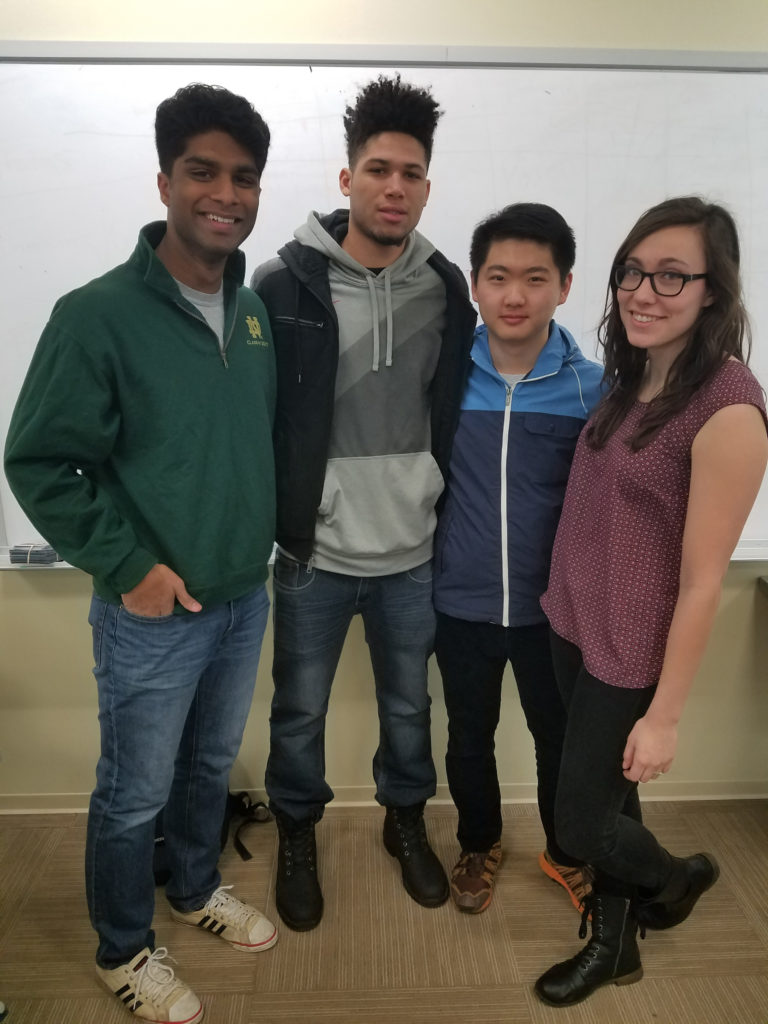
Author: Cheong In
Prototype Plan Summary: CHS Team A
Meant to address the prototype setting, tenets of testing, and feedback activities for our three major ideation focuses.
Connect Clay: The Bridge Program
Consider the Setting –
The setting for this solution is Clay High School. The goal is to expose our “target user” – middle school students– to all that Clay has to offer. The more time those middle school students spend at Clay, with Clay mentors, with Clay teachers, in Clay programs, the more likely they are to develop a desire to attend CHS. Human nature is to tend towards continuity, so we must provide that continuity and we must build that bond. Connect Clay is the way to do that.
Define What to Test:
With the Connect Clay program, we need to assess whether or not students would be willing to participate in the programs, and if it would affect the way that they think about Clay.
Questions:
Would going to a program like this improve your perception of Clay?
Would you tell your parents about a program like this?
Would you like to participate in such a program? If not, what kind of program would you like to see?
Define Feedback Activities:
In order to gather this feedback, we could put out interest surveys about these hypothetical programs.
We could station ourselves in a public space (grocery store area? Public library?) and ask passersby if they would be interested in participating in the programs to extract community opinions.
Conduct “exit” interviews with seniors at Clay to see if they would have liked such programming.
Video Marketing Approach:
Consider the Setting –
The Video Marketing Approach that we will be taking takes place at any platform where video can be played, from informational sessions to social media.
Ideally, it will be shown in the classrooms at Clay and at local middle schools.
Finally, we want the video to be posted on social media platforms, reaching students and parents through word of mouth.
Define What to Test –
Whether a video will have any impact on what potential Clay students and parents think about CHS. What kinds of impact might it have? Will people believe the video?
If other parents, neighbors, family friends sent their children to CHS, would that affect your opinion of CHS? Would you consider sending your child to Clay as a result?
Ask administrators if such a program is possible? Ask parents if they would be willing to help out with such a program? See if any FTT students would be interested in overseeing project.
- Questions:
- What did you think of the video’s message?
- What setting did you view the video in?
- Does the video help you change your perception of Clay?
Define Feedback Activities:
Conduct a survey following the presentation of the video to ask about effectiveness.
Play the video for non-CHS students and ask them if they would go to school there?
Ask middle school students if a video might have impacted their school choice?
Offering Opportunities // Building a Better CHS
Consider the Setting –
Building a Better CHS has to do with utilizing the school’s current art resources, its students to make the school environment be one that students will want to study in. Thus, the setting is within the school, and the people involved in this setting are the current CHS students.
Define What to Test –
We need to test how students would feel about the changes to their learning environment/school? Also if they would have a more positive outlook on Clay if they were proud of how their school looked.
- Questions:
- Would students be interested in participating in this project?
- Does the way the school looks influence how a student feels about the school?
- Do the students want more color in their hallways?
Define Feedback Activities:
Survey the current students on their thoughts on the state of the school.
Find pictures from other schools that have creative/colorful environments and show those to current students to gather their opinions.
User value Criteria:
- Availability of relatable touchpoints
- Accessibility
- Effectiveness of engagement
Provider value Criteria:
- Ability to monitor progress and performance
- Cost-friendliness
- Ease of implementation
Solution Evaluation Matrix:
User Value Criteria
| Relatability | Accessibility | Engagement | Total | |
| Connect Clay | 4 | 4 | 5 | 13 |
| Building CHS | 2 | 4 | 4 | 10 |
| Video | 3 | 5 | 3 | 11 |
Provider Value Criteria
| Monitor | Cost | Ease | Total | |
| Connect Clay | 4 | 4 | 2 | 10 |
| Building CHS | 5 | 3 | 3 | 11 |
| Video | 2 | 4 | 3 | 9 |
Patterns and Guiding Principles
Bottom Up Synthesis of CHS Project
Written by Tyler Prestly, Madi Purrenhage, Faisal Shariff, and Michael Yu
After the creation of our gallery wall, the next step in our innovative problem solving process was to look for insights and patterns in the information we had collected. To look for patterns, we tried to clump together insights that occurred two or more times. The following are criteria with which we tried to look at the patterns and then a list of the patterns themselves.
For Each Pattern We Asked:
- Is it a true pattern?
- What is surprising or interesting?
- Was this an unexpected or supported behavior?
PATTERN ANALYSIS
*** Image depicts our initial observation of patterns, further progress was made upon these.
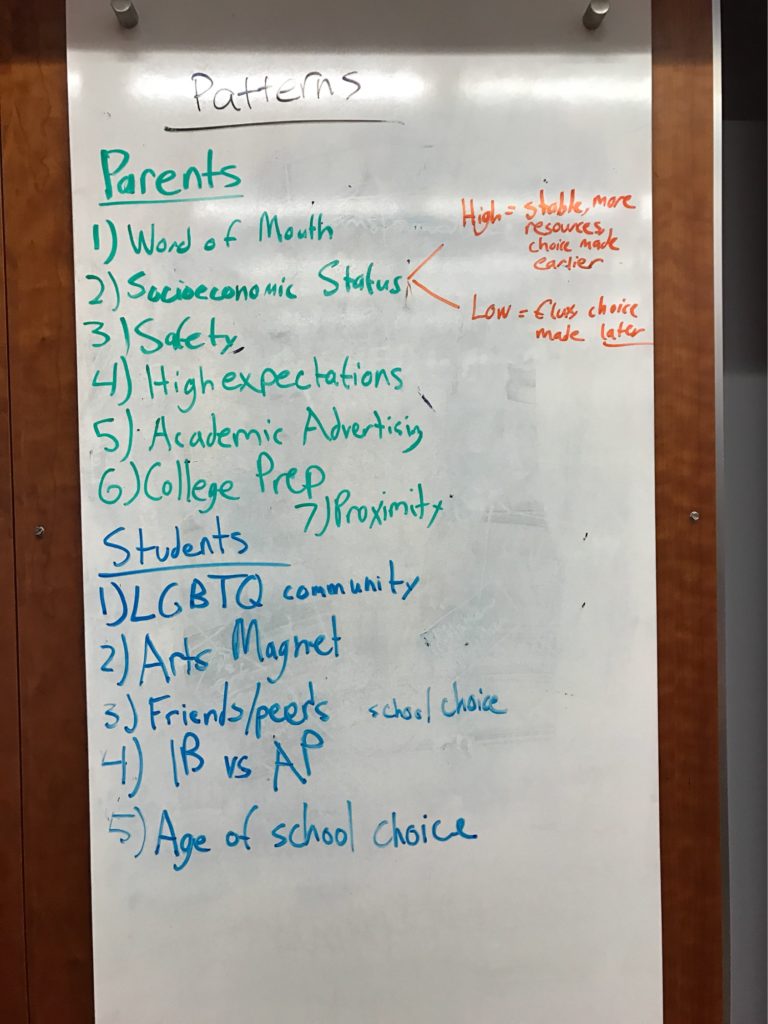
- Word of Mouth is essential in the HS decision making process for students and parents alike.
- Parents begin talking about the schools when their children are at a young age
- According to Maria C., and various discussions with current Clay students
- Jackson Jones, for example, was mostly influenced by his father’s fandom of Clay athletics and knew he’d attend Clay since childhood.
- Parents are highly influenced by what their friends and colleagues do
- Sophia’s father worked at ND and all of his fellow ND professors sent their children to Adams, so he did too.
- Students will also follow where their friends go, like Jackson Jones and David Weaver.
- According to Maria C., and various discussions with current Clay students
- Parents begin talking about the schools when their children are at a young age
- Socioeconomic status is a significant variable in school choice and approach.
- Based on discussions with Maria C., parents from each spectrum
- High = More financially stable, more resources/wherewithal, agency -> High School Choice made EARLIER(early in a child’s life)
- Low = Flux, fewer resources, less agency -> High school Choice is made later
- Based more on transportation, safety, who they know
- Want to be able to make the decision based on academics, but can’t always afford to do so
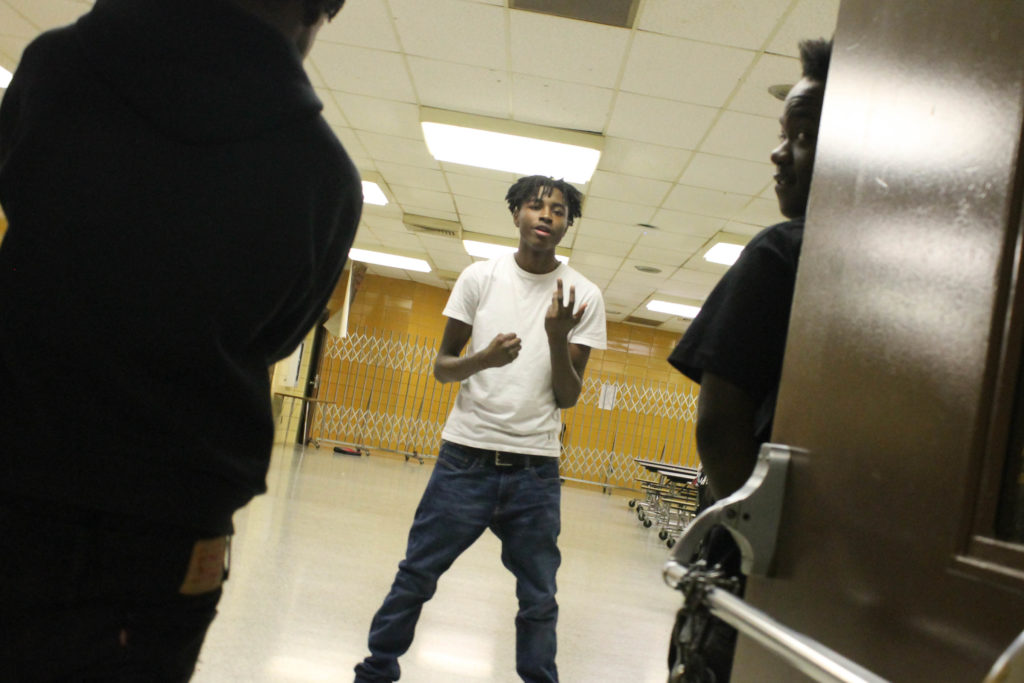
- Safety: Every parent wants their children to be safe.
- Clay has been known in the past to be unsafe do to the students who attend
- Principal Eid himself talks about the number of expulsions, which can be seen as a positive (Commitment to safety) and a negative (high rate of expulsions = high amount of dangerous students).
- Students themselves also care about safety:
- Sophia B. gave us the insight that Adams is not dramatically safer than Clay. “I was threatened my freshman and sophomore year at Adams… girls told me they were going to cut me.”
- Adams just has a better reputation for safety, and Clay is slowly improving theirs.
- Maria C.: “Fights do occur at Adams too”
- User survey: “I feel safe on campus” led to a score of 3.45/5
- In a world of instant access to media, this has become more important and more of a problem (negative press -> less students choosing Clay)
- Community: Parents want their children to be in a supportive, familial environment with a good energy.
- McKenna: “When I walk through the halls, I don’t want to see a bunch of students being disciplined. I want to see students and staff being able to interact, joking around, having fun, laughing.”
- Sue: “When everything’s going smoothly you don’t have as much need for support, but when you have a couple challenges, we’ve had good support from the guidance office and the teachers.”
- High Expectations: Parents want their children to reach their full academic potential.
- Based on discussions with various parents and professors
- Parents want the school to be challenging
- Parents want the teachers to support and push their children to achieve
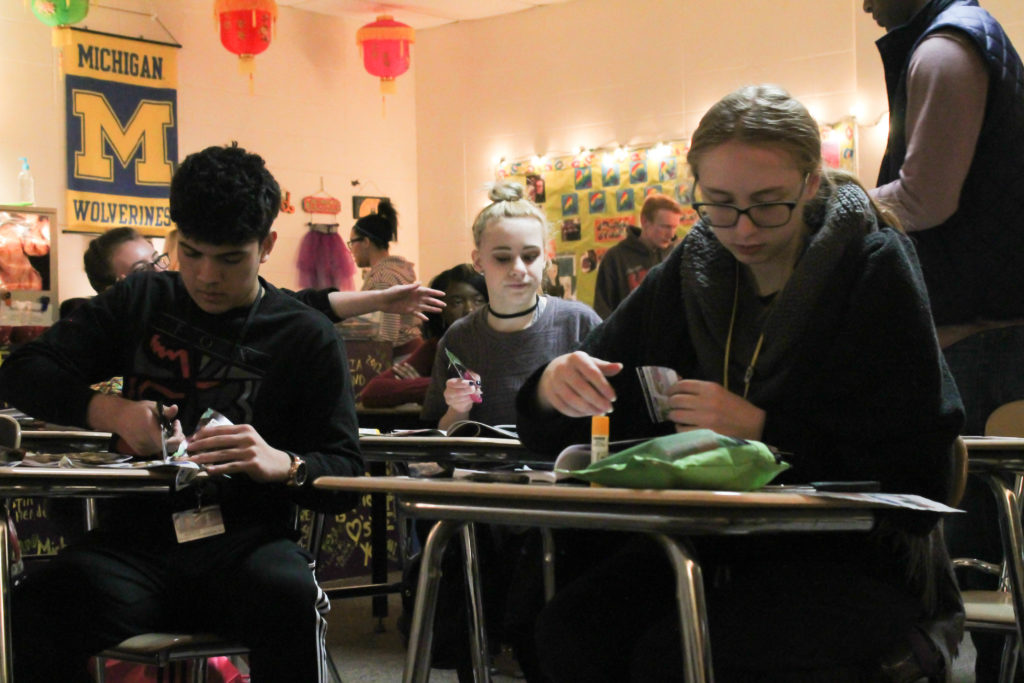
- Based on discussions with various parents and professors
- Academic Advertising is weak: People think Clay doesn’t have strong academics, and they have not adequately addressed their academic offerings in their marketing.
- The current marketing materials that Clay has does not have much information on the AP/Dual Credit offerings
- SBSC, in the past, restricted them from doing focusing on anything else but the “Arts Magnet”
- But in reality Clay has one of the best AP/Dual credit course offerings in the area
- The current marketing materials that Clay has does not have much information on the AP/Dual Credit offerings
- Importance of College Prep – parents and students alike think it is important that a school prepare them to attend college.
- This trends more among adults and self-motivated students
- Adams sends people to Ivy League, Clay does not
- Students like Momin M. made Adams as their school of choice because of how an IB diploma would look to colleges
- Misconception about college acceptance from Clay (62%-> 4 year colleges)
- The CTE program is an advantage, but parents need to see college prep too.
- Where to find information is a complex issue.
- Maria C. expert conducting research on school choice, believes that a big part of the problem is people don’t have the proper information/know where to find it.
- People receive their information from a variety of places
- There is not an established path or method that parents or students know, the process is more nebulous and flowy

- Currently the Arts Magnet name provides value in:
- Students rank it as an important part of the school
- Potential for enhancement of school spaces
- It diversifies Clay’s offerings
- Education trend towards realizing the potential of art -> Improves outcomes in science and math.
- Detracts value in:
- Weaker academics and athletics
- Having a hard time with the academic elements
- Currently the Arts Magnet name provides value in:
- Diversity is a strength of Clay High School
- Probably one of the most ethnically diverse student bodies amongst high schools in the area
- This is beneficial because it is a place where other minorities can feel comfortable and safe
- Additionally, it enriches the learning environment with unique perspectives and backgrounds
- AP vs. IB should influence the academic perceptions of both schools among the community
- Clay’s listing of AP courses is not widely known.
- Not mentioned in the SBSC pamphlets to prospective students and parents
- Clay has the most amount of AP programs and is continuing to grow.
- Adams may offer the IB program, but few end up with the diploma
- Maria, Sophia: “Many enter the IB program, but very few end up completing (only about 15 or so in their year)
- AP program is more valuable since having those individual credits can help their college experience more than an incomplete IB track
- Admissions offices have noted that they value AP course credits as much as IB diplomas
- Clay’s listing of AP courses is not widely known.
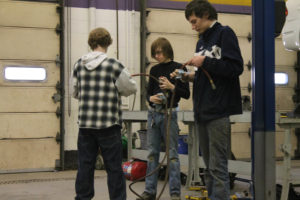 CTE is highly successful in preparing students for full time careers.
CTE is highly successful in preparing students for full time careers.
- CTE programs have helped students like David Weaver find their place at school in these classes, and go onto reliable jobs after graduation.
- Discussion with Auto Shop teacher: Students have gone onto jobs at local auto shops, with little need for job training
- Making them more attractive candidates for the job
- One former student has even been able to find a position at Ford Motors, and has been a major success story for the program
- Discussion with Auto Shop teacher: Students have gone onto jobs at local auto shops, with little need for job training
- Clay has the most diverse listing of CTE programs compared to the other three schools in the district.
- One of the upper hands Clay has on the others
- Main reason why students like David W. chose Clay.
- Marketing these listings better to students who may not be academically minded may be able to attract students from other high schools to focus on CTEs as their priority
- One of the upper hands Clay has on the others
- CTE programs have helped students like David Weaver find their place at school in these classes, and go onto reliable jobs after graduation.
- There’s significant pushback from the school district in Clay’s efforts.
- As seen with marketing decisions, lack of help on school image, promoting Adams as the “academic school”, etc.
- Efforts will have to rely more on Clay’s resources, rather than what the district can do for Clay.
- School district may not be a partner in the final solution.
- Distance is a dealbreaker for some, but is manageable for most.
- In the user survey, 16 students “strongly agreed” with the fact that they chose this school because of how close they live to Clay.
- However, the survey average was a 2.35 out of 5, which suggests that distance is not a factor for most students.
- As long as transportation is provided, students like those leaving the Clay district to attend Adams are willing to take a longer trip to go to the school of their choice.
- The solution should look to target a broad swath of students for the entire South Bend area, not necessarily those from the immediate neighborhood.
- Lack of school pride and attractions makes word of mouth harder
- Discussions with various students on campus note the community, the arts magnet as their favorite things about the school
- User survey: “I am proud to be a Clay Student” results in a 3.6/5.
- Immersions, however, identify that all of this is restricted to inside the classrooms, and stops in the hallways. Campus is very bland.
- Immersion experiences point to a restrictive environment, with constant overwatch.
- Student to student interaction between classes highly discouraged
GUIDING PRINCIPLES
After identifying important and valid patterns, the team looked through them and prioritized the most important factors. These important factors play into the guiding principles, or the tenants that provide the highest level of direction and organization for concepting.
About Clay and What People Value:
- I need to feel safe in my school.
- The perception exists that CHS is a bad choice/unsafe/does not provide value.
- This is untrue, and proving it incorrect is core to our solutions, it encompasses the whole issue we are trying to address.
- Parents care about the safety of their children.
- Joyce – a low income mother of 2. Said she “ain’t got time for her kids to be bullied.”
- Prof Maria would have sent her kids there if they had wanted to go
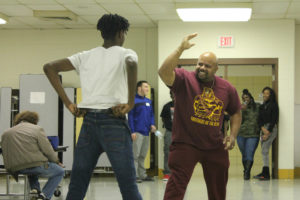
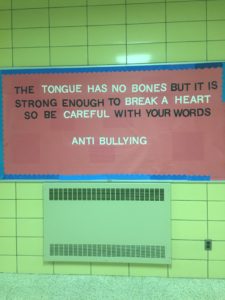
“But if I had a choice, I would have put them in Clay. It was the most impressive in terms of the full package – arts, athletics, caring community, and dual credits. My kids chose something different because their friends chose something different, which we respected and were fine with.”
- I value the Arts when choosing a school.
- Students value the arts magnet.
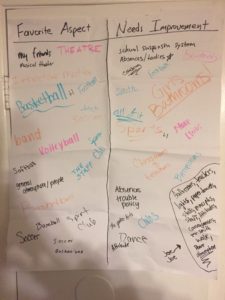
- On our graffiti wall, many students noted that the magnet and the arts were important reasons for their HS decision.
- Students value the arts magnet.
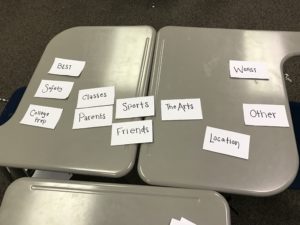 The Card Sort and User Survey also provided insight that the magnet matters.
The Card Sort and User Survey also provided insight that the magnet matters.
- It was listed as important countless times on the user survey and in the card sort.
- The arts provide value beyond art itself.
- The students could create and build a school that looked like an arts magnet.
- Well-rounded diversified student interests.
- Studying art helps students to more effectively learn math and science.
- “They are very focused on them and have tons of opportunities with the Magnet” – Laura
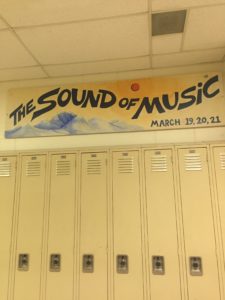
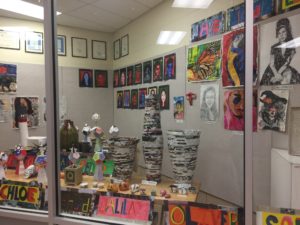
3. Academics are of top importance in my school choice.
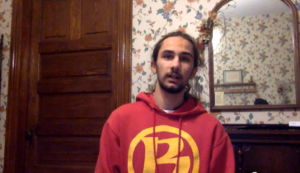
- “Some of the decision was based on the fact that IB diploma would look best to colleges” – from an interview with Momin Mirza
- IB vs. AP
- There is currently a misconception about the value of IB and AP. This misconception leads to the perception that Clay doesn’t provide as much value.
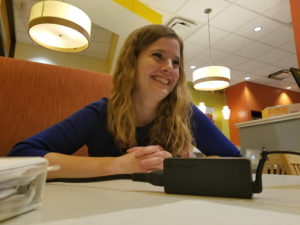
- “Clay isn’t known to have a lot of high academic rigor, and that was more important to me than the arts. Arts are supplemental, academics was the focus for my family.” – from the interview with Maria Caponigro
- There is currently a misconception about the value of IB and AP. This misconception leads to the perception that Clay doesn’t provide as much value.
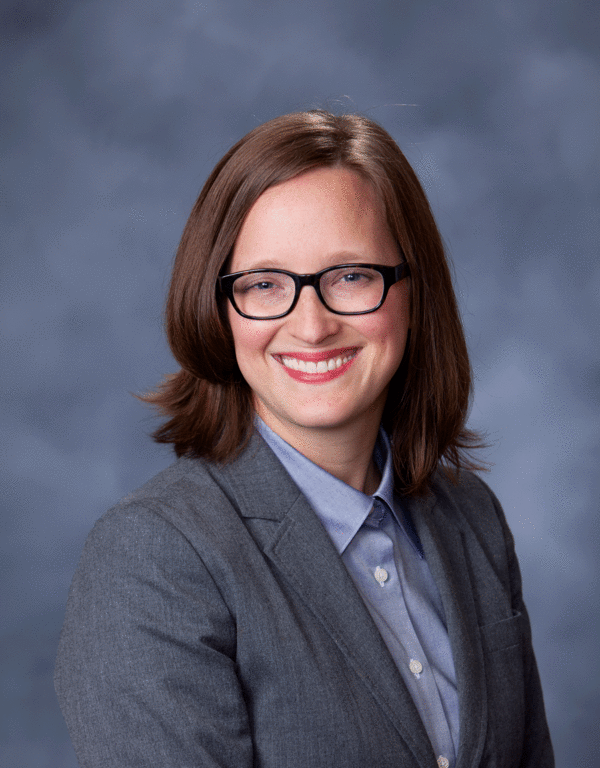 “The academic element is essential, and the structure for her kids to learn.” – from the interview with Professor Jenny Martin
“The academic element is essential, and the structure for her kids to learn.” – from the interview with Professor Jenny Martin
- Parents want their children to be pushed to their potential
Appeal to me by Word of Mouth.
- Influences on the Decision: Word of Mouth, Reputation, and School Pride
- In order to drive enrollment, we had to look at what influenced the High School Decision… from our research we are focusing on the three tenets listed above.
- Important Insights:
- Students are choosing schools based on where friends go
- Parents are choosing schools based on where other parents send their children (Word of Mouth).
- “Parents pick schools based on word of mouth, based on what their friends say” “Choosing a school in South Bend is like a game of telephone” – Professor Maria McKenna
- In order to improve Word of Mouth, you have to influence school reputation.
- Marketing Matters. Recreating the Story – the marketing materials, building bridge with middle school.
- Specialist at IDEO recommended that when addressing marketing we try and tell a story and identify what story CHS should be telling.
DESIGN CRITERIA
Design Goal:
- What have we learned about target customers?
- Diverse needs: socioeconomic, ethnic, sexual orientation
- Care about quality of schooling(staying on track), safety, keeping students out of trouble
- Design needs to show parents that Clay High school can provide what they are looking for, that Clay is a good choice and will benefit their children. That Clay is as good if not better than other schools in the area.
- After the analysis of our target market, we believe that our target market should be students as opposed to parents.
- This means both high school students and middle school students and we will approach our solutions to these groups in different ways.
- Additionally, there are smart students who currently live in the CHS neighborhood and bus to Adams, addressing those students will be a future focus.
- User Perceptions?
- Word of mouth
- CLAY’s identity is extremely important
- Needs to be defined and spread throughout the school and the corporation, they need to lean on this to attract students
- Diverse, good academics, safe, Artsy = well-rounded
- Proposed offering is extremely important, it could benefit them by giving them piece of mind that their children are in good hands, on the right track, and receiving a quality education
- Aesthetic attributes: Brochure needs to look nice, Clay High school facilities need to be spruced up a little (i.e. locker painting)
- HUGE reputational aspects
Problems/Needs/Opportunities:
- Preferred outcome is that their children graduate, are on track and prepared for whatever route their future is going down(college, workforce, etc.)
- Paint points:
- Lack of knowledge/awareness of Clay High School’s offerings, benefits, positive characteristics: about why Clay is good.
Functional Attributes:
- Does the design of the offering need to accommodate specific scenarios?
- There are a variety of variables that will play into the final offering, and as such, the offering is not expected to have to adapt to every single student.
- However, the end offering will try to impact and influence students who are artistic, academic, athletic, and a whole slew of other character traits. We hope that it will appeal to a large variety.
- Does the design need to address specific compatibility or standard issues?
- If the end design involves an upgrade to CHS marketing materials, we will have to ensure compatibility among the current and future materials.
- We will also have to ensure compliance with SBSC.
- We will also have to address compatibility with current programming at the school. If we recommend a variety of engagement techniques for middle school students we will need to ensure our recommendations are compatible with the current situation.
Constraints:
- What are the confines of our project work? What limitations might there be?
- Ideally, we would change the whole way that students and parents approach school choice… and innovate on the system itself.
- However, there are a variety of limitations that we foresee.
- Clay is starting from behind in terms of attracting academically high achieving students. Adams has the advantage here of precedent, legacy, current situation. Adams has smart students and continues to attract more smart students because of that. Clay has some high achieving students but struggles to attract more (80 of its smartest students are bussing to Adams every morning). These students are KEY to breaking this cycle and making lasting change.
- Obviously there are going to be budgetary constraints. CHS receives funding per student, 6600 vs. 11,000 per student in Penn-Harris-Madison District because of property tax disparity.
- Limitations based on the fact that the SBSC seems to favor Adams
- Constraints on our ability to academically advertise
Gallery Day Overview
It was a pleasure to meet Principal Eid and Ms. Willis at the gallery day in Stayer Center. I felt that we had a very genuine discussion about the scenario we face at Clay High, and while I expected there to be a lot of overlap of what they already know and what we found in our research, I was glad to see that we were able to identify new factors and trends that may help us address Clay High’s issues. I felt that the journey map was the most valuable part of our day, explaining and pointing out the shortcomings at each moment of the school decision process.
Here were the main takeaways:
- There is a clear obstacle created by the school district government when it uses marketing and brochures to boost Adams High’s appearance and bring down the other three high schools in the area. The school has a lot going against them, but we do think there are ways to circumvent those efforts and contribute to the word of mouth and relationships that helps Clay High get the enrollment.
- We are dealing with two targets: students and parents. Each have their individual needs and goals, so the solution to increase enrollment at Clay will be a multifaceted one. The immersions and ethnographies certainly helped, but we may want to see a few more subsets of students and parents to really get a good sense of the whole population.
- There are very addressable issues with the school’s image. For Clay High to be an art magnet, it should embrace their students’ art throughout the halls, give it color, and enliven the environment. As seen with the immersion, Clay feels repressive, strict, and uninspiring in certain parts of the campus, especially with its patrol and security protocol. Improving those parts may help it make a more inviting place for prospective students.
- As for gaps, I do think that we haven’t really addressed the socioeconomic element of this issue as much. One thing we found and began to consider through our expert interview was that where people attend high school and why they do are drastically different for people with different financial or racial identities. Lower class families are less likely to look at what we assumed to be the primary source for information and will simply rely on word of mouth or just proximity and safety. So while improving the marketing materials may be important, it may be more worthwhile to design a program that revolves around improving how families of Clay students communicate with prospective families. This leads to another discussion – what type of students are we really looking for? Do we simply want to increase enrollment? Or do we want to target a certain socioeconomic class? I do think that while our interviews have provided us with perspective from the extreme ends of the parents, we should pay more attention to the lower income family and minority families more, since it would be more representative of the surrounding South Bend community.
Work Around Photos
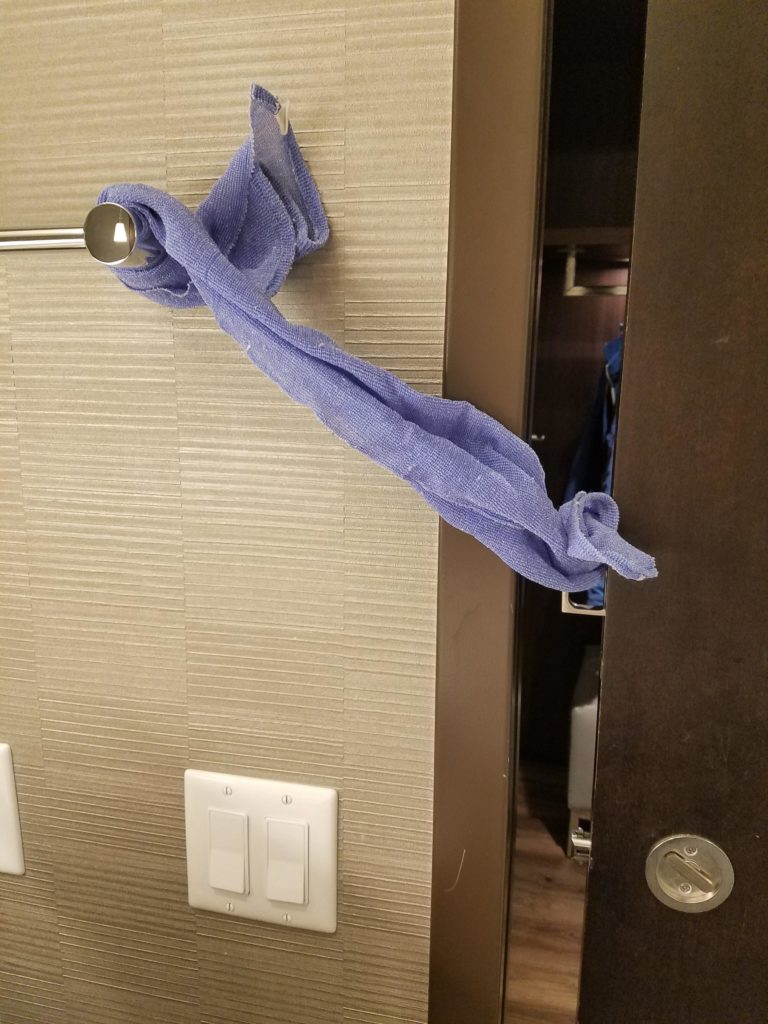
During our trip in Buffalo to cover Notre Dame Men’s Basketball for The Observer, we stayed at a hotel whose bathrooms had sliding doors that didn’t have functioning lock mechanism. There would be a handle that would pop out (as seen above), so we tied a towel around the towel rack and the handle to keep the door from sliding open.
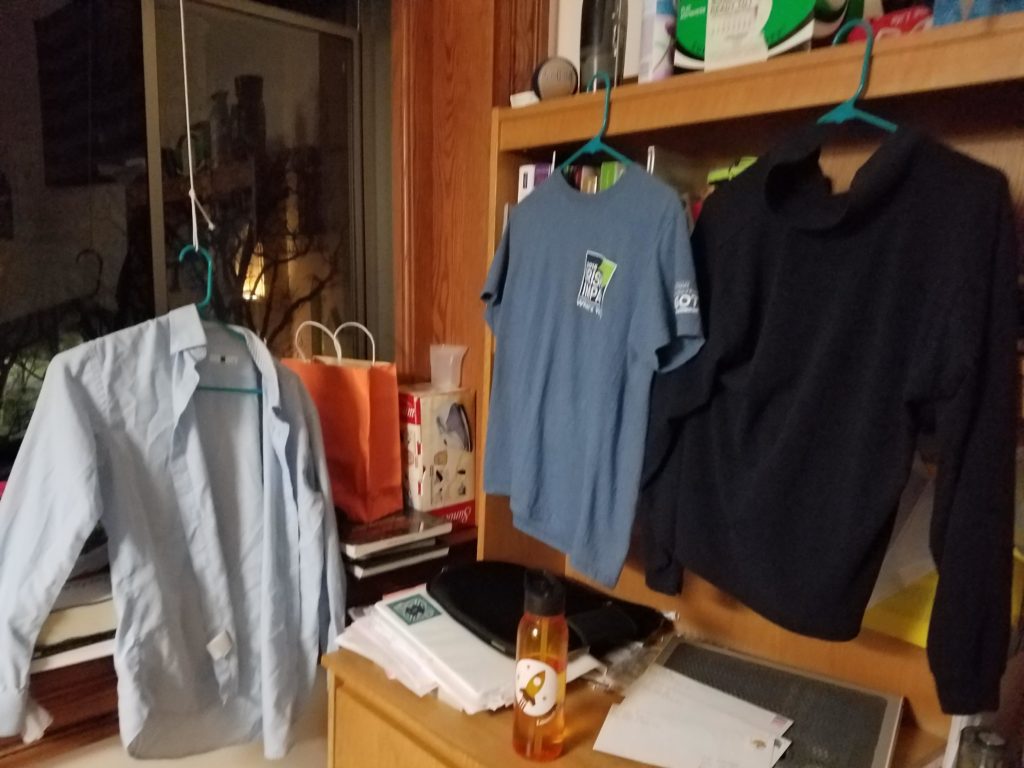
When we returned from the trip, I did my laundry on Sunday, only to find out that the laundry machines were broken and couldn’t drain out the water. So I had to drip dry my clothes after the dryer couldn’t get all the water out. I didn’t have a drying rack, so I had to every possible edge to hang my clothes around my room.
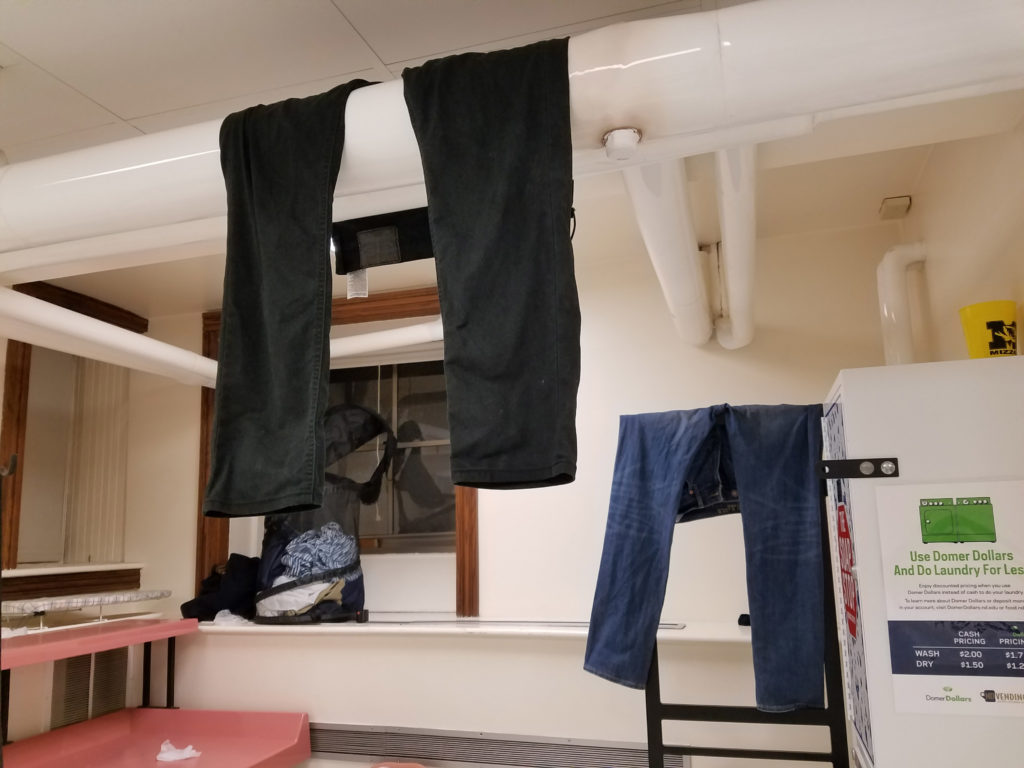
Others in the dorm were less considerate, and hung the clothes over the pipes and the detergent vending machine to do the same.
Analogous Immersion – Michael
Type: Analogous Immersion – Deciding my college
Stage 1: I knew that I had to get my college right. My sister had just selected her college after a major debate with my parents, where she chose a lower ranked college compared to the others she had been accepted to. She prioritized going to the East Coast, as well as pursuing a path to medical school. I knew that I would have to get this right and make sure I can pick a school that my parents could also support.
Stage 2: I began the college application process by eliminating the ones I knew I didn’t have the academic qualities for. Then I went down the list of the US College News and World Report Rankings and picked out ones that fit my interests: journalism and business. I only considered business because my parents really felt that a business school would better prep me for a career than journalism, so schools like Washington University in St. Louis, Dartmouth, and UCLA were only there to appease my parents. I was really looking at Northwestern (Which I applied Early Decision for), USC, and UC Irvine.
Stage 3: When Northwestern had turned me down, I went back to the drawing board and went through stage 2 again. I wanted to better my chances of being accepted into a college my parents could get behind, so I picked about six more, adding schools like Case Western and Carnegie Mellon to improve my chances, despite not having an in-depth knowledge about them.
I had been talking to my College and Career Counselor about doing a multimedia interview for our student newspaper about her experience as a flight attendant, but she was wondering if she could talk about her experiences as the first cheerleader for Notre Dame in 1969. I then got to learn about Fr. Hesburgh, what Notre Dame meant to the world, and the possibilities that the school offered. I had inadvertently found out about Notre Dame two weeks before the Common App was due.
Stage 4: The common app and supplementary materials were stressful at times, but I felt that I had the right resources to get the job done to the best of my abilities. My parents found a college admissions advisor to help me hone my college choices and review my essays. I had a lot of resources to go through thanks to my school’s College and Career Center, so I knew what scholarships to look for, etc.
Stage 5: After being admitted to my schools, I managed to immediately eliminate schools like USC, UC Irvine, and Pepperdine and ultimately bring it down to Boston College and Notre Dame. I remember eliminating journalism schools entirely, as I felt that I could pursue that interest through student publications. So looking at publications like The Observer and The Heights (Boston College) was high on my priority list. I also wanted to prioritize the quality of the business programs, as well as campus life and
I went into our campus visits giving Notre Dame a 70-30 favorite over Boston College, but after an eventful and hectic trip around South Bend and my sister’s campus tour of BC, I came home feeling 51-49, which began to stress me out. But the day after we returned, the Boston Bombing occurred, which was enough to convince my mom that I should go to Notre Dame. I think I would have chosen ND regardless, but it made the decision a little bit easier on my mom.
Stage 6: I submitted my intent to enroll a week after our visit, and senior year went by quickly for the rest of the year. I had AP exams to worry about, but much of my time after that was spent learning more about my future school. The admissions office sent me packets of information about move in, first year of studies, and campus life that got me even more excited.
Stage 7: As a Notre Dame student, I worked to help make Notre Dame a more common destination for seniors at my school. I’d visit and tell underclassmen what the school had to offer, and why they should apply.
Takeaways:
- It is crucial to have a network of friends, family, and experts like my College Counselor and Applications advisor to go through the admissions process as best as possible. I don’t think I would be where I am today without them.
- I feel it is my duty to give back to people who helped me get to where I am today. I continue with word of mouth recommendations, and help underclassmen to get to where they want to go.
- Correspondence really matters to prospective students. One-on-one meetings were ten times more effective than brochures and handouts. Multimedia also helps. One of the most important videos were “Any Given Day” which helped illustrate Notre Dame’s academic and campus life.
Immersion – Clay HS Cafeteria
Date of observation: March 3, 2017
Location: Clay High School Cafeteria
Type: Immersion
During our research day on campus, we stopped by the cafeteria during lunch hours to gather our materials and thoughts, and I noticed several trends and activities in the area. Here are some photos I took during that time:

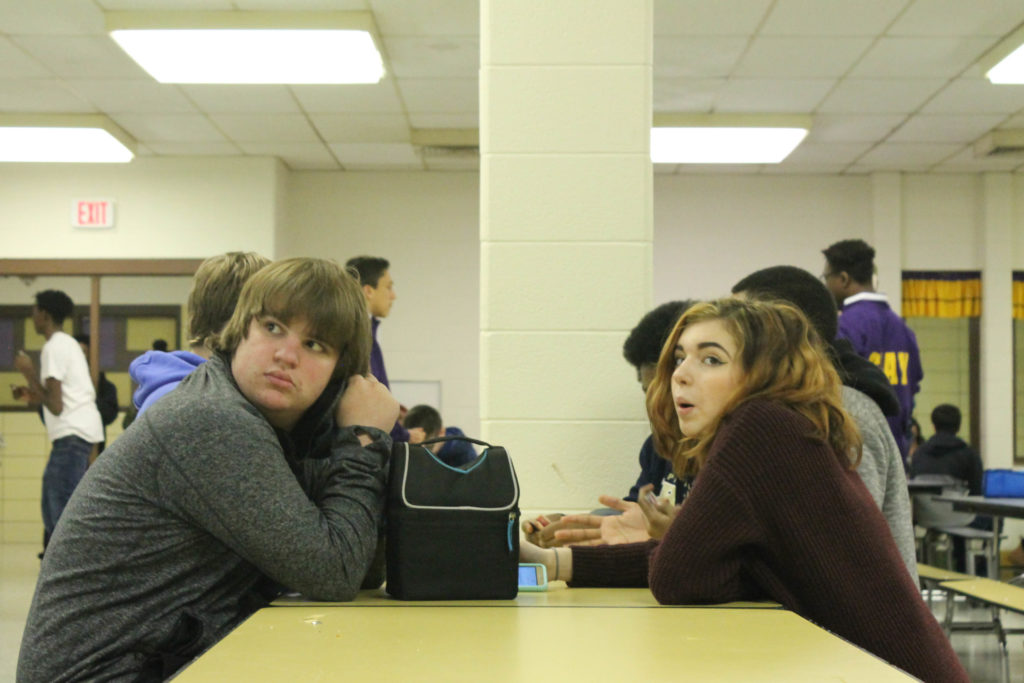
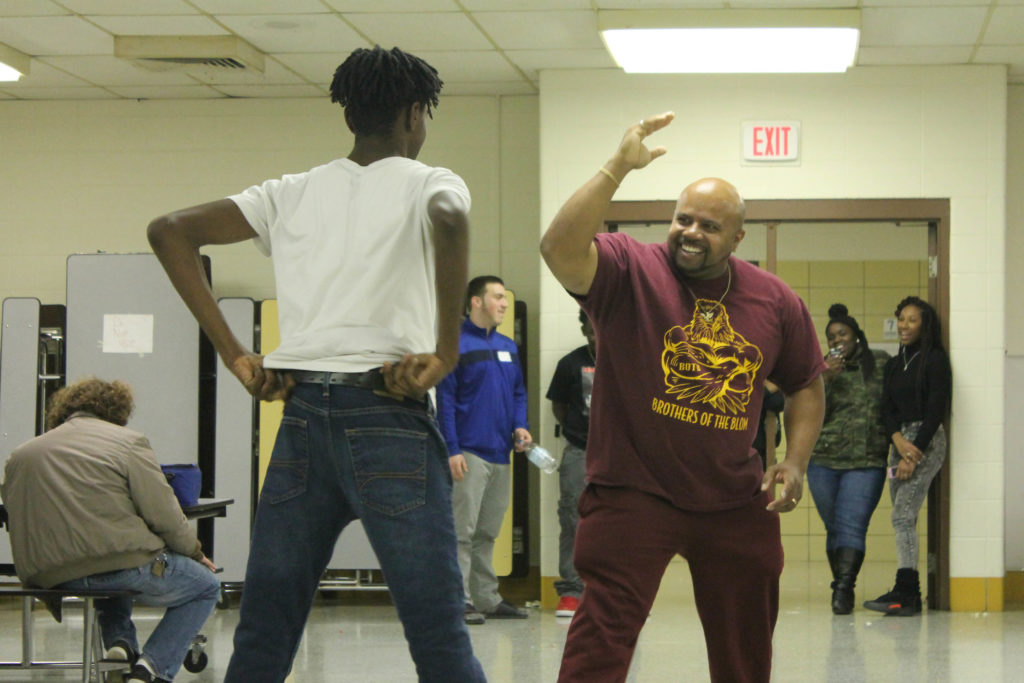
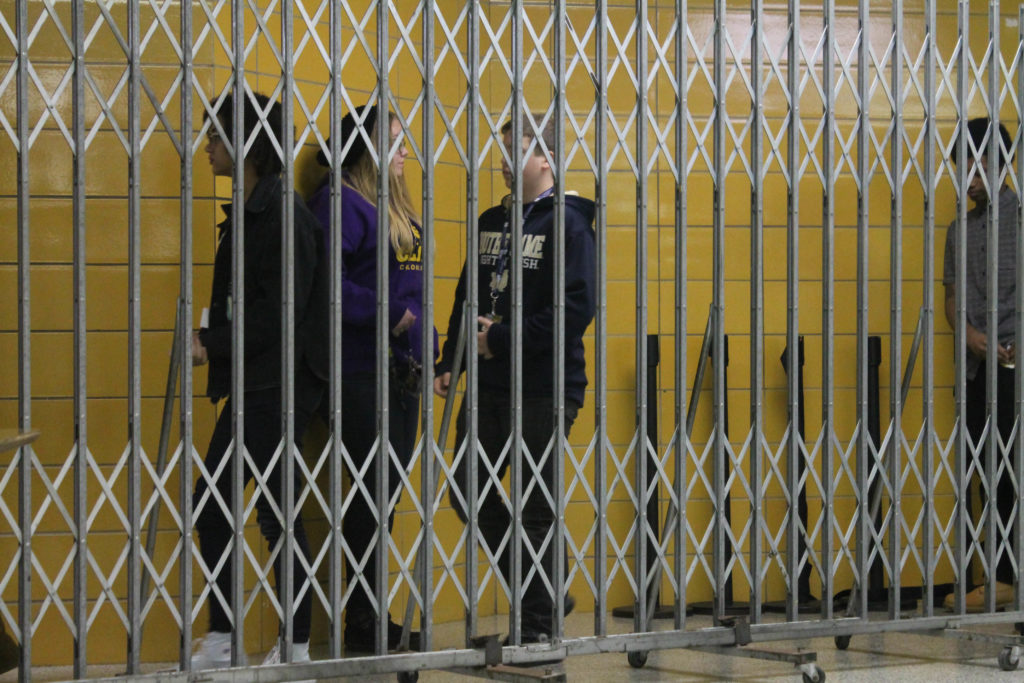
Takeaways:
- Students would either gather in large groups among their friends or eat alone.
- There was a lot of roughhousing going on, which made me somewhat uncomfortable during the stay. I was reassured with the security patrols/ coaches walking around, but it seemed pretty rowdy even with them around.
- Almost no one was eating anything, which I thought was strange for lunch time. Most students were busy socializing, and only a few were eating small snacks. However, I don’t know how much I’d be able to focus on eating in an environment as busy as the cafeteria…
- I’ve noticed that a lot of the raucous behavior continued as students began to leave the cafeteria, and students were straggling to return to their classes.
- The environment as a whole is uninspiring and restrictive. The other half of my discomfort came with this sensations that I was locked in the space; students can’t roam about the campus freely, and to be in a specific space for a set amount of time is uncomfortable.
Interview 10 – Student Interview: David Weaver
Ethnographic Summary
David Weaver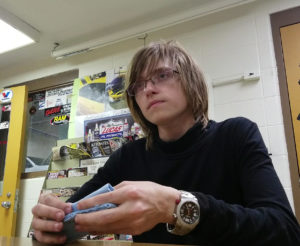
Quick Bio: Senior at Clay High School. Heavily involved in CTE, specifically Construction and Transportation. Attended Brown Intermediate. Gets A’s and B’s in classes.
Date: March 3, 2017
Location: Clay High School Auto Shop
Type of observation: Interview
Team participants: Conducted interview alone
Age: 12th grade
Why did he choose Clay High?
- Brother and sister attended Clay High, so the decision was already made for him.
- David also lives nearby.
- CTE Programs best fit his interests
Environment:
- During what the CTE instructor considered an “off-day”, where students were working on cleaning up equipment.
- Two other classmates were working with him, with several students walking in and out of the room. Some welding CTE students came by to drop off a tire rack they had created in the other class.
Notable comments: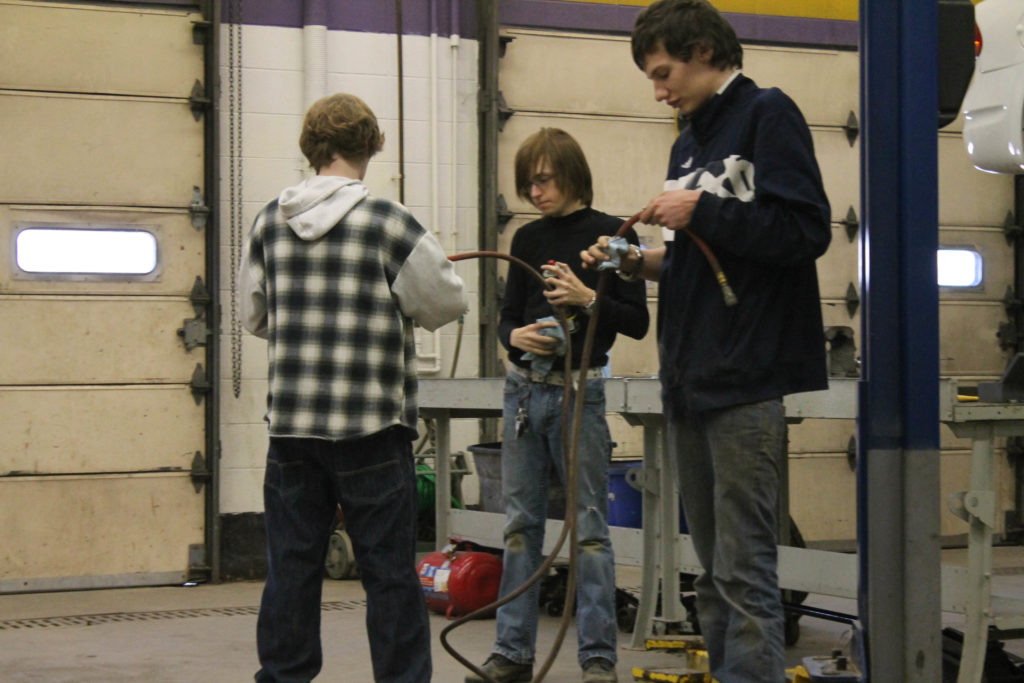
- Used to be in ROTC, but program was cancelled while he was attending.
- Planning to go to school like Ivy Tech to further CTE education.
- Guidance counselors are involved in his development, and likes the teachers he has had.
- Studied at Riley briefly for a construction CTE course; worked in an actual house for real world practice
Key Insights:
- Program does a good job already with preparing students for immediate employment, and instructors can help students get scouted into their jobs.
- CTE could be a really valuable resource and marketable program for those not as interested in academics.
Interview – Student Interview: Jackson Jones
Ethnographic Summary
Jackson Jones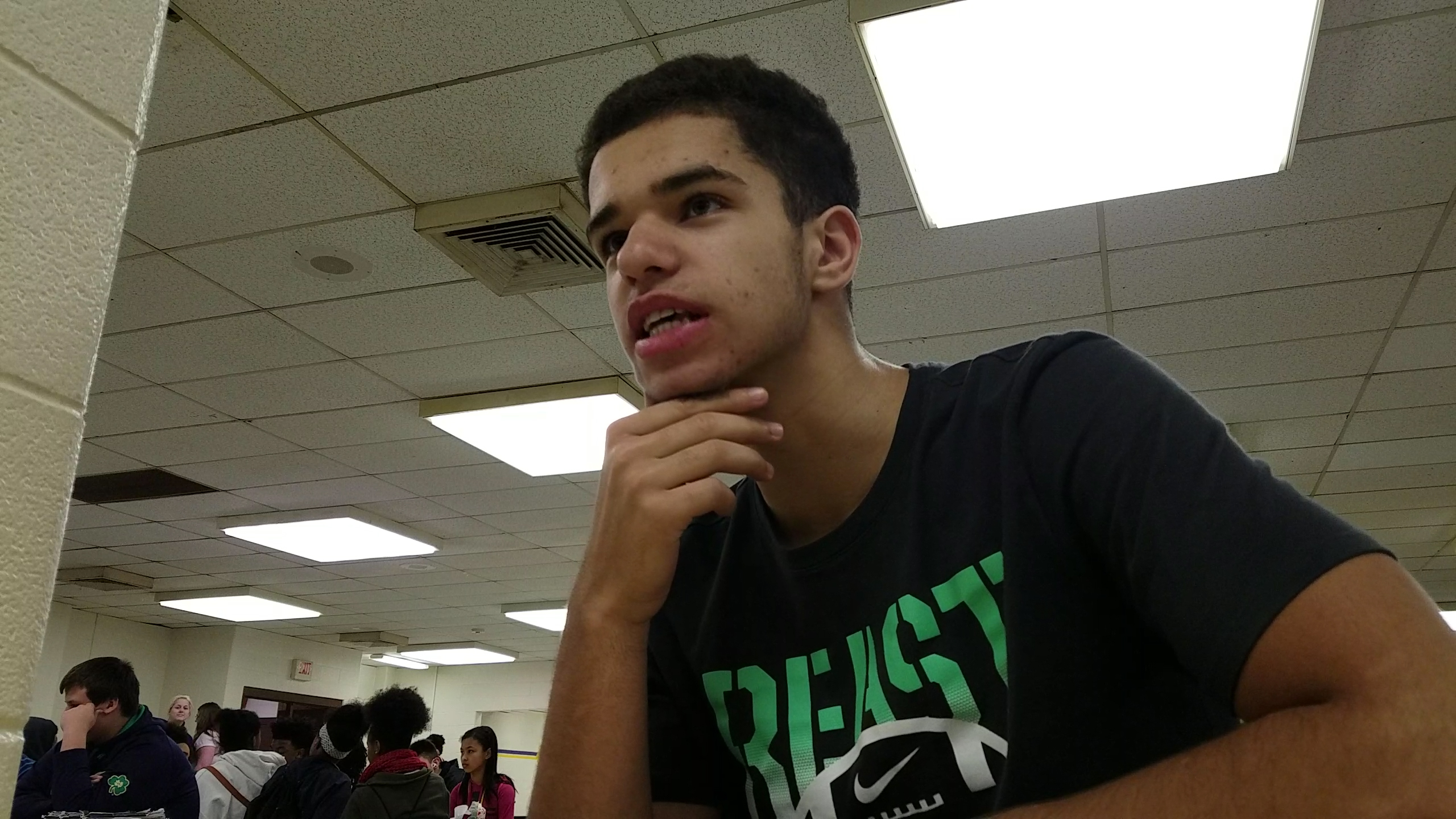
Quick Bio: Freshman at Clay High School. Wide Receiver for Freshman/JV team, and plays basketball and baseball. Attended Clay Intermediate.
Date: March 3, 2017
Location: Clay High School Cafeteria
Type of observation: Interview
Team participants: Conducted interview alone
Age: 9th grade
Why did he choose Clay High?
- Didn’t really have much of a say; his father was a huge Clay Colonials fan and used to be a big high school athlete when he attended Clay.
Environment:
- Last period of lunch in the Café O’ Clay, the cafeteria on campus. Less than a dozen students were actually eating something.
- Dozen students were roughhousing nearby
Interactions:
- Was hanging out in the cafeteria with Macey Ginzer, who is also a freshman and is deeply involved in sports like Jackson. The two are close teammates, as Macey is the quarterback who sees Jackson, the wide receiver, as his “go-to guy”.
- His basketball coach interrupted the interview, and managed to persuade him to drop trying out for baseball this season. Wanted him to focus on basketball so he can develop into a varsity player, rather than playing JV for three different sports. Coach wants him to follow his father’s footsteps.
Notable comments:
- Being an athlete doesn’t automatically keep you from being involved with the Fine Arts programs on campus. Jackson is definitely interested in dance, singing, and acting. While he identifies sports as the most important activity in his life, fine arts comes as a close second.
- Teachers have been somewhat detached with his development; Jackson suffered from a concussion earlier last season and had to miss several days of school, but never received extra help to help get back on track. Ended up struggling with the course and drop down to a subpar GPA.
- The LGBTQ community is a factor in a lot of reasons why people he knew is transferring of Clay. The transfer students are not necessarily homophobic, but LGBT students often bully others and pester others. Clay is also commonly considered to be a “gay school” according to other research.
- Jackson doesn’t feel safe walking down certain parts of the campus. However, he’s learned which parts to avoid or how to defuse a situation whenever he’s approached by someone he doesn’t know, based on experience.
Key Insights:
- Sports do have some pull power when it comes to deciding schools, like it did in Jackson and his father’s case. But athletes can also be intrigued and motivated by other quality programs, like fine arts, despite the stereotypes that might counter this idea.
- There should be a test on how much quality teachers bring to their students. Jackson believes that a lot of students transfer out because they don’t feel attended to and begin to dislike their teachers. Jackson was grateful when one of his teachers did help him out during his injury, so being able to engage and support students in situations is a key way to retain those enrolled.
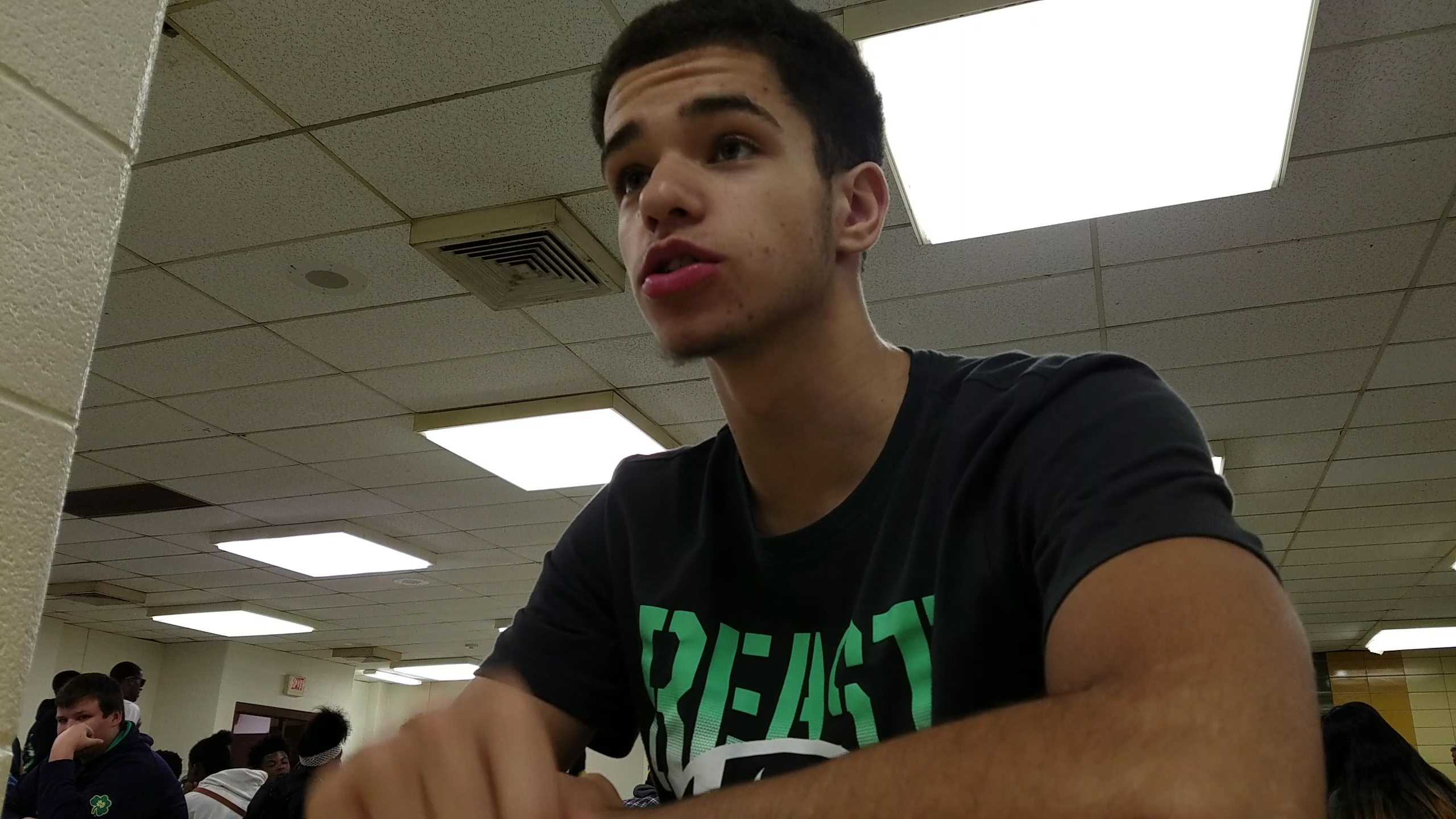
Clay Renaissance
